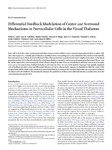Differential feedback modulation of center and surround mechanisms in parvocellular cells in the visual thalamus

Use este enlace para citar
http://hdl.handle.net/2183/14642
A non ser que se indique outra cousa, a licenza do ítem descríbese como Creative Commons Attribution 4.0 International License (CC-BY 4.0)
Coleccións
- Investigación (FCS) [1293]
Metadatos
Mostrar o rexistro completo do ítemTítulo
Differential feedback modulation of center and surround mechanisms in parvocellular cells in the visual thalamusAutor(es)
Data
2012-11-07Cita bibliográfica
Jones HE, Andolina IM, Ahmed B, Shipp SD, Clements JTC, Grieve KL, Cudeiro J, Salt TE, Sillito AM. Differential feedback modulation of center and surround mechanisms in parvocellular cells in the visual thalamus. J Neurosci. 2012;32(45):15946-15951.
Resumo
[Abstract] Many cells in both the central visual system and other sensory systems exhibit a center surround organization in their receptive field, where the response to a centrally placed stimulus is modified when a surrounding area is also stimulated. This can follow from laterally directed connections in the local circuit at the level of the cell in question but could also involve more complex interactions. In the lateral geniculate nucleus (LGN), the cells relaying the retinal input display a concentric, center surround organization that in part follows from the similar organization characterizing the retinal cells providing their input. However, local thalamic inhibitory interneurons also play a role, and as we examine here, feedback from the visual cortex too. Here, we show in the primate (macaque) that spatially organized cortical feedback provides a clear and differential influence serving to enhance both responses to stimulation within the center of the receptive field and the ability of the nonclassical surround mechanism to attenuate this. In short, both center and surround mechanisms are influenced by the feedback. This dynamically sharpens the spatial focus of the receptive field and introduces nonlinearities from the cortical mechanism into the LGN.
Versión do editor
Dereitos
Creative Commons Attribution 4.0 International License (CC-BY 4.0)






